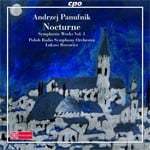3(III=picc).2.2.bcl.2.dbn-4.3.3.1-timp.perc(4):SD/TD/cyms/tgl(sm)/BD/tam-t-pft-strings
Abbreviations (PDF)
Boosey & Hawkes
I composed my Nocturne soon after the horrifying events of the Second World War, which I experienced in my native Warsaw.
In this orchestral piece, I completely detached myself from the tragic memories of the past years. I was escaping reality, weaving for myself a kind of night vision, as in a dream - seeing at the beginning cloudy and mysterious images, which gradually emerge clearer and clearer, building very slowly and irrevocably up into an orgiastic climax, then transforming little by little back into the misty images as at the beginning, softly dispersing until they fade out completely.
My Nocturne won first prize in the Karol Szymanowski Competition in Poland, and soon after (1948) I was allowed to go to Paris to conduct its first performance. However, the next year the situation of every creative artist in Poland changed drastically. This was the crucial 1949 when a most significant conference of Polish composers was organised by the Communist Party. Here, for the first time, a fierce attack was launched on 'formalism' in music. 'Formalism' has many complicated and obscure definitions in theory, but in practice a 'formalistic' work was one which could not be used as political propaganda. Worse still, its musical language related to the Western 'decadent' contemporary composers. We received strict orders to compose for the 'broad masses', using the 'method of socialist realism', which meant to write music 'national in form and socialist in content'. My Nocturne was performed during this conference. Being an abstract work and having no power to 'mobilise' politically, being neither 'national in form' nor 'socialist in content', it was labelled 'formalistic'.
With regard to form as opposed to 'formalism', this work is designed as a great arch in sound: at the beginning, from absolute silence emerges a muffled tremolo on the side drum. Other instruments gradually join in, mounting in a widely protracted crescendo to a point where they achieve maximum volume of sound - and after this extended climax, the sound very gradually decreases, once more right down to side drum tremolo then to silence. The end and the beginning, which mirror each other, both convey a sort of counterpoint of sound and silence.
Andrzej Panufnik
Reproduction Rights
This programme note can be reproduced free of charge in concert programmes with a credit to the composer

Polish Radio Symphony Orchestra/Lukasz Borowicz
CPO 777 497-2
